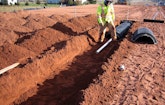Interested in Drainfield Media?
Get Drainfield Media articles, news and videos right in your inbox! Sign up now.
Drainfield Media + Get AlertsAerated filter system rejuvenates drainfield
Problem: Every home in Glenwood, a 300-home subdivision built in the 1970s in Nebraska, used an individual septic system. At the time, there were no local regulations, and 1,000-gallon concrete tanks were installed and outfitted with 50- to 100-foot drainfields on an old blue clay riverbed with a soil percolation range of 50 to 60 minutes per inch. Throughout the 40 years, many of these systems failed. A large-scale treatment solution was sought.
Solution: Nathan Cramer of All American Sewer & Drain found the S.O.S.-Save Our Septic Program through Bio-Microbics. On one of the problem sites that he was pumping every few weeks, he installed a RetroFAST system in the tank under this program. After he had the septic tank pumped, cleaned and inspected for leaks and deficiencies, he installed the retrofitting aerobic system inside the existing tank.
Result: By sending less-loaded, higher-treated and oxygen-rich effluent into the drainfield, the clogged biomat around the drainfield trench sides and bottom began to perc and repair itself. Within the next couple of weeks under observation, the visible signs of failure had subsided and clear, bubbling effluent was visible in the tank. Since then, four other properties have been repaired. 800/753-3278; www.biomicrobics.com.
Fitting a residential drainfield in a tight space
Problem: A homeowner preparing to sell a three-bedroom house in North Attleboro, Massachusetts, had an existing leachfield located on an adjacent lot under an easement. The town required the leachfield to be placed on the property, but the site had limited space, setback issues and restrictive layer concerns.
Solution: A system was designed by Dana Clow of Advanced Concepts Engineering to fit on the property and meet the site’s challenges using 18 Mantis M5.2 units from Eljen Corporation. The compact size and design flexibility allowed the system to fit within the limited space and work around the site’s restrictive layers and features.
Result: The installation was easily and successfully completed by King Excavating, allowing the homeowner to meet the Title 5 requirements to sell the home. 800/444-1359; www.eljen.com.
Rural community care home utilizes pressurized system
Problem: The Burnside Community Care Home in Clyde River, Prince Edward Island, Canada, is a three-level, 40-bed facility. Due to the rural location, connection to a city sewer system was not an option, and Engineering Technologies Canada Ltd. (ETC) was hired to design a cost-effective and environmentally sound onsite treatment system.
Solution: With soil conditions consisting of compact, fine sandy loam glacial till with layers of sandstone rock, Kelly Galloway, ETC principal engineer, recommended an advanced decentralized treatment system with a soil-based, pressurized Infiltrator Systems leaching chamber dispersal field using Quick4 Plus Standard Chambers. The field is constructed in a raised-bed of sand fill and receives effluent from an advanced secondary sewage treatment system. It includes multiple zones, each fed by a mechanical indexing valve, allowing the use of smaller, lightweight pumps and simplifying future expansion. The mechanical distributing valves are fitted with electronic monitors so the system can be monitored remotely.
Result: The system has been in operation for more than a year serving the facility’s needs. “At the end of the day, we have what we feel is a green and well-functioning system,” says Burnside owner Alan MacPhee. 800/221-4436; www.infiltratorsystems.com.








